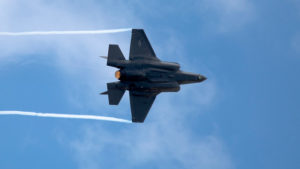The Air Force has officially stood up a new program executive office dedicated to advanced aircraft that will help the service realize its goal of fielding a new fighter aircraft in five years and hone emerging critical technologies.
PEO Advanced Aircraft was stood up Oct. 2 at Wright-Patterson Air Force Base, Ohio, according to a Wednesday service release. Will Roper, the service’s assistant secretary for acquisition, technology and logistics, told reporters that plans were in place to set up an office dedicated to Next-Generation Air Dominance (NGAD) technologies in a September briefing at the Air Force Association’s annual Air, Space and Cyber conference outside Washington, D.C.

The office is meant to “transform” the NGAD program into a new “Digital Century Series” initiative, in which the Air Force would harness digital engineering, modular open systems architecture and agile software development that will lead to faster production of aircraft together with a “significantly lower learning curve.”
Col. Dale White was named as the new leader of PEO Advanced Aircraft; he most recently served as PEO for Intelligence, Surveillance, Reconnaissance (ISR) and Special Operations Forces, handling a $22 billion portfolio spanning the lifecycle of ISR and SOF platforms and subsystems from initial development to sustainment.
In a Wednesday ceremony at Wright-Patt, Roper expressed his confidence in White running point on one of the Air Force’s key technology development programs for the next decade.
“I am turning to this program and to Dale in particular to find a way to bring the best technical expertise that we have to bear … to see if there is a way we can continue innovating, doing things smaller, faster, more agile where you don’t have to necessarily be a company that can build a thousand things to work with us,” Roper said. “If there is a yes to be found in this universe, you [White] will find it.”
The Air Force has begun funneling more money into research-and-development for NGAD as the F-35 Joint Strike Fighter program moves closer to full-rate production and the service must consider what a sixth-generation fighter looks like.
The service requested $1 billion in research, development, test and evaluation (RDT&E) in the fiscal year 2020 President’s Budget for NGAD, to fund a yet-to-be-determined platform and related systems that would give it a renewed edge in air combat. The request has been met with some skepticism from lawmakers: The House Armed Services Committee’s version of the FY ’20 National Defense Authorization Act (NDAA) cut $500 million from the request (Defense Daily, June 10). The House passed the HASC version of the NDAA in July. The Senate Appropriations Committee’s version of the defense spending bill, which was approved by the committee Sept. 12 but did not gain 60 votes on the Senate floor, includes a classified reduction of $40 million to NGAD (Defense Daily, Sept. 12).
Meanwhile, service officials have acknowledged that they need to do better at clarifying their NGAD plans to Congress moving forward (Defense Daily, Aug. 7).

The new Digital Century Series approach was first reported by Defense News in September. In an interview with the outlet and ensuing roundtables with reporters at AFA, Roper described it as a return to the efforts of the 1950s and 1960s, where contractors rapidly developed and fielded new fighter aircraft, which were not intended to last for decades but instead built quickly to meet the current threat. His target is to field a small number of the Air Force’s next fighter jet within the next five years, then have industry return to the drawing board and build new aircraft derived from the newest technology at that time.
Air Force Materiel Command Commander Gen. Arnold Bunch elaborated more on the nascent PEO’s role in a Sept. 18 interview with Defense Daily at the AFA conference.
Back in the original Century Series days, “we had multiple companies building multiple aircraft and we were trying new experiments and trying different things,” he said. “What we’re doing differently here though – it’s not all about just a vehicle. … It’s weapons. It’s sensors. It’s communications. It’s radios.
“The spectrum of what we’re looking at is broad, and we’re making investments in a lot of those areas,” he continued. “it’s not just to say we’re going to go buy a platform. … I may roll some of those technologies into things I have in the files already, to create that step up in performance overall.”
The key difference in the NGAD approach as opposed to prior development programs will be the open mission systems operating as a backbone for next-generation technologies, Bunch added. The hope is that having contractors designing and developing products based on this common backbone will allow the service to “leapfrog” the technology over time, avoiding the longer design and build timeframes that were experienced with the F-22 Raptor and the F-35 Joint Strike Fighter, he said